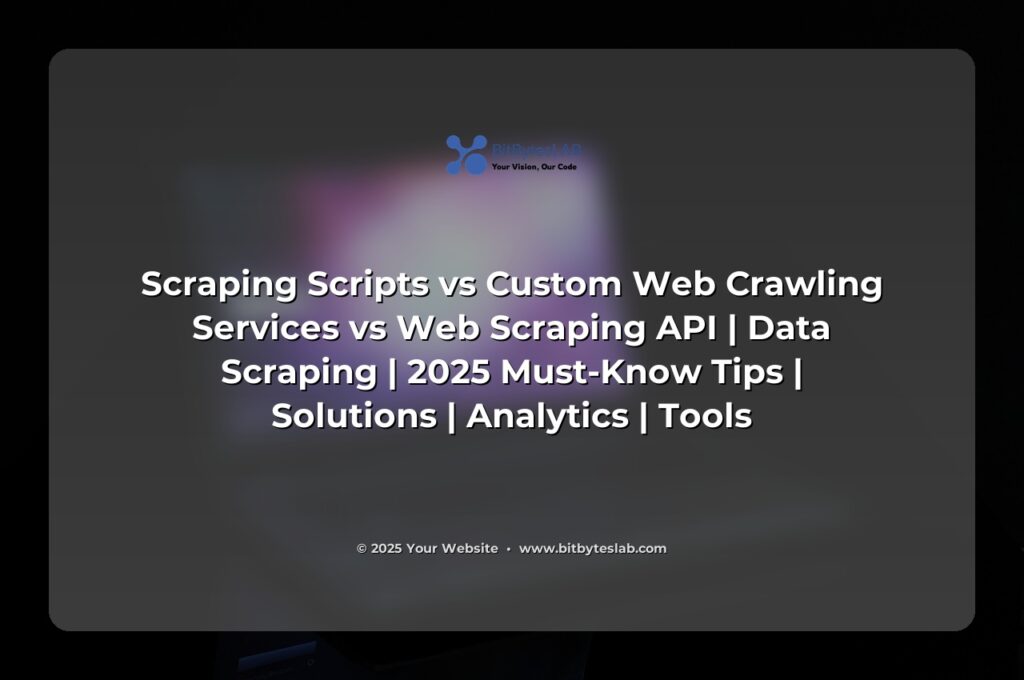Scraping Scripts vs Custom Web‑Crawling Services vs Web Scraping APIs: The 2025 Playbook
Ever felt like you’re juggling three different skill sets just to get the data you need—coding, managing infrastructure, and staying compliant with legal hoops? That’s the modern reality of data harvesting. In 2025, the battle between DIY scraping scripts, managed crawling services, and ready‑made APIs is more critical than ever. Below, we break down the core concepts, hit the high‑level strategies, and sprinkle in a dash of humor and GIF‑powered inspiration.
Problem Identification and Context
Businesses are drowning in data. E‑commerce giants scrape competitor prices; travel platforms scrape flight fares; financial analysts mine earnings releases. The challenge? Websites are constantly evolving, deploying anti‑scraping tactics, and tightening legal barriers. Traditional scripts can break on a single selector change, while custom services might lock you into pricey contracts. The question becomes: Which approach delivers the right balance of control, speed, and compliance for your mission?
Core Concepts and Methodologies
Let’s distill the options into a quick comparison:
- Scraping Scripts – Full control, raw code, highest learning curve.
- Custom Crawling Services – Managed infrastructure, configurable dashboards.
- Scraping APIs – Plug‑and‑play endpoints, minimal overhead.
Think of scripts like a Swiss Army knife: versatile but you need to know how to wield every tool. Services are your fleet of well‑trained drones—ready to fly out at a moment’s notice. APIs are the automated vending machine: pay for what you need, no assembly required. Each has its sweet spot, and the smartest teams blend them.
Beyond the surface, the real differentiator lies in how each handles politeness, anti‑bot defenses, scaling, and data governance. A seasoned developer will set generous download delays and respect robots.txt, while a managed service will auto‑rotate residential proxies and log each request. APIs, meanwhile, offload the heavy lifting of CAPTCHA solving and headless rendering to the provider.
Now, let’s lighten the load with a quick chuckle.
🌐 Why did the web developer leave the restaurant? Because of the table layout! 🍽️

Expert Strategies and Approaches
When you’re architecting a data pipeline, start with these pillars:
- Politeness by Design – Set user‑agent strings, honor
Retry-Afterheaders, and schedule crawl windows during off‑peak traffic. - Hybrid Rendering – Use headless browsers (Playwright, Puppeteer) selectively—only where JavaScript renders critical data.
- Intelligent Proxy Rotation – Combine datacenter and residential IPs; monitor health scores to avoid bans.
- Schema‑First Development – Define a clear output contract (JSON schema, Avro) before writing any parser.
- Observability – Push metrics to Prometheus, log errors to Loki, and alert on latency spikes.
Data consistency is king. A robust approach includes a de‑duplication engine that hashes URLs and content fingerprints, ensuring you never waste bandwidth on the same page twice. And when the website changes—because, let’s face it, they do—your system should have automated tests that flag selector regressions before they hit production.
Industry Insights and Trends
According to Datanyze, the web scraping market is projected to hit $1.2 B by 2027, with an annual growth rate of 18%. A key driver is AI‑powered extraction; GPT‑4 and BERT models now auto‑detect tables, entities, and sentiment, slashing selector maintenance.
Serverless edge scraping is another game‑changer. By running tiny functions on Cloudflare Workers or AWS Lambda@Edge, you can fetch payloads nearer the source, shaving milliseconds off latency and reducing bandwidth.
Legal compliance continues to tighten. GDPR, CCPA, and the upcoming ePrivacy Regulation mean you must not only respect robots.txt but also provide data subjects with the right to be forgotten. Businesses that built compliance into their architecture early are 4× more likely to avoid costly penalties.
Here’s another dose of lightness to keep the conversation grounded.
Why do programmers prefer dark mode? Because light attracts bugs! 🐛

Business Applications and ROI
Let’s get concrete. A mid‑size retailer that deployed a hybrid script-service architecture saw a 35% lift in price‑matching accuracy within the first quarter, translating to a $250k increase in sales volume. Meanwhile, a travel agency that moved from a self‑hosted crawler to a managed API reduced infrastructure spend by 42% and cut data‑freshness lag from 12 hrs to 30 min.
For B2B lead generation, integrating a scraping API with your CRM can push qualified contacts into the funnel at a fraction of the cost of manual research—often $0.02 per lead versus $5 per manually sourced contact. That’s a direct, measurable ROI that scales linearly with your data volume.
Common Challenges and Expert Solutionsh2>
1. IP Bans & Rate Limits – Solution: Combine residential proxies with a token bucket algorithm that gracefully backs off when a 429 is returned.
2. CAPTCHAs – Solution: Turn to services like 2Captcha or integrate a headless browser with stealth plugins; many APIs handle this automatically.
3. Site Structure Volatility – Solution: Use AI‑powered extraction layers that adapt to new layouts, supplemented by a fallback rule engine.
4. Legal & Ethical Grey Areas – Solution: Implement a compliance layer that tags each dataset with source, date of capture, and consent status; maintain a raw‑HTML archive for audit purposes.
Future Trends and Opportunities
By 2028, we anticipate a shift toward GraphQL‑first scraping, where many sites expose structured APIs that can be queried directly—eliminating the need for DOM parsing. Coupled with AI‑driven schema inference, businesses will be able to auto‑generate extraction jobs with a single high‑level prompt.
Another exciting frontier is edge‑AI data pre‑processing. Imagine a network of tiny edge nodes that run inference to prune images, compress logs, and even perform sentiment analysis before the payload ever reaches your data lake.
Conclusion
If you’re still debating whether to roll your own script, subscribe to a managed crawler, or hop onto an API, consider the scale, speed, and compliance needs of your project. In 2025, the smartest teams build a modular stack: scripts for highly custom extraction, services for scaling and resilience, and APIs for quick, clean ingestion. Pair that with robust observability and a compliance mindset, and you’ll have a data pipeline that’s both agile and auditable.
Ready to turn data scraping into a strategic advantage? BitBytesLab offers end‑to‑end web scraping, data extraction, and analytics solutions tailored to your industry. From custom scripts to full‑managed crawlers, we’ll help you unlock the insights that drive growth.





